Dawning Of The Light: Pharaoh Akhnaton – Part IV
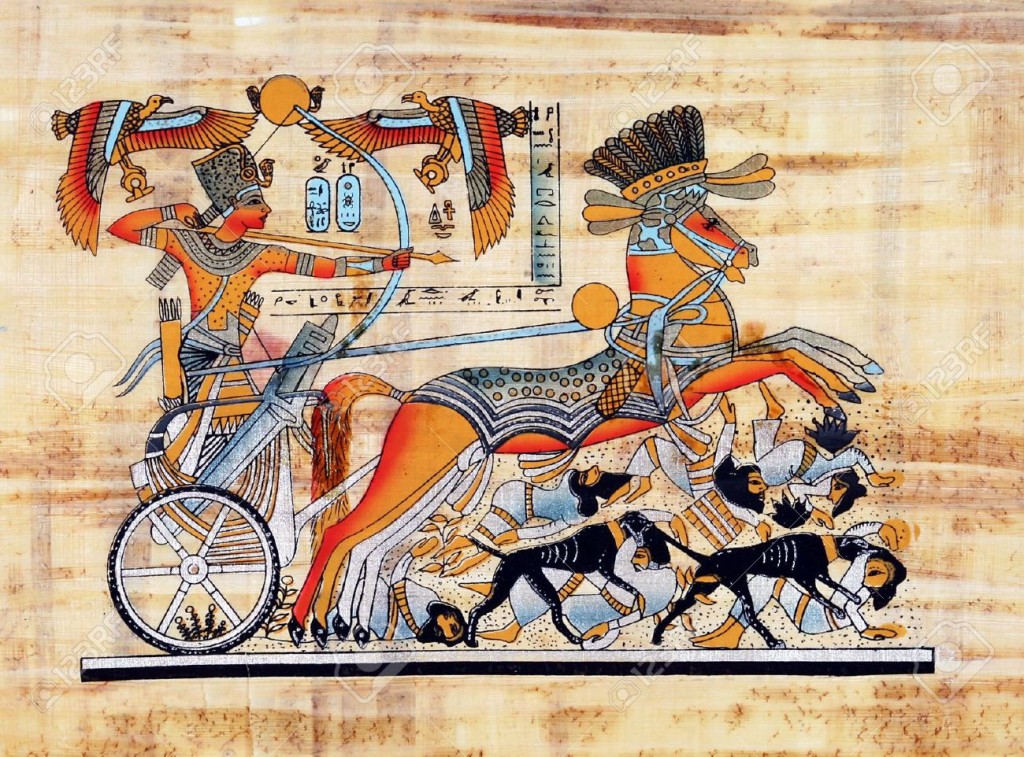 Pharaoh “Ratut,” his queen, and their young friend and constant companion Rahotep, often went hunting in the Theban neighbourhood. In those days the great morass attracted and harboured large quantities of game. The marshes provided the boy king with all kinds of wildfowl. The desert afforded a varied field for the skill of the royal sportsman, who hunted in his chariot. Bulls, lions, gazelles, and hares were his favourite game.
Pharaoh “Ratut,” his queen, and their young friend and constant companion Rahotep, often went hunting in the Theban neighbourhood. In those days the great morass attracted and harboured large quantities of game. The marshes provided the boy king with all kinds of wildfowl. The desert afforded a varied field for the skill of the royal sportsman, who hunted in his chariot. Bulls, lions, gazelles, and hares were his favourite game.
One day in the spring of 1350 B.C., when Pharaoh was nineteen years of age, he was on a hunting trip with his devoted wife and Rahotep. He came in from the hunt, riding vigorously into camp in his chariot, which prominently displayed the royal golden solar-hawk on its poles. “Ratut’s” name was incorporated on the solar disc fixed on the head of the hawk. Since the Pharaohs were looked upon as the sun-god’s earthly representatives, it is obvious that this device symbolized Ratut’s “solar” (space) origin!
The young ruler had slain a lion this day, aided by his slughi hound, and he was excited; excited as any teenager would be over such a conquest. However, these hunting expeditions on the desert were not all that they appeared to be. It was partially for relaxation, true, but it was also to get away from teeming Thebes and be able to meet with certain visitors and officials without being under the suspicious eyes of the Amun priests!
However, “Ratut” was betrayed, and the evil priesthood finally knew the guarded secret that had been well kept for nine years. Poison was placed in the drinking water near Pharaoh’s tent. “Ratut” was thirsty from the hot, desert ride in the open chariot and asked his friend, Rahotep, to procure him a drink. Therefore his best friend killed him innocently without even knowing it.
The priests believed that if they removed the “psychic” channel from the hated Aton meetings, they could force Ay and Maya to their will. They especially desired the knowledge that only Maya in all the land of Egypt knew!
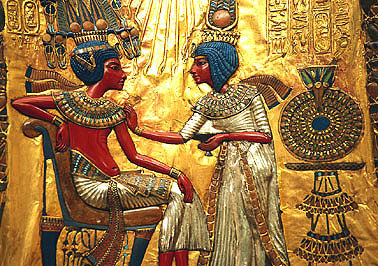 When Pharaoh realized he had been poisoned and betrayed, he had Rahotep summon Queen Ankhsenamun. Before he passed into transition, he looked at his beloved queen, and his dearest friend, Ra: “Today I killed a powerful lion with my spear, and is this not symbolic of the fact that I have aided in the making of the SECRET PLACES OF THE LION? We children of Aton have ‘killed’ the lion and hid him from the view of the profane. I know that even as I am now pictured on my chariot as a human-headed lion, I shall in centuries yet to be born be symbolized as the Winged Lion [Mark, the Evangelist].
When Pharaoh realized he had been poisoned and betrayed, he had Rahotep summon Queen Ankhsenamun. Before he passed into transition, he looked at his beloved queen, and his dearest friend, Ra: “Today I killed a powerful lion with my spear, and is this not symbolic of the fact that I have aided in the making of the SECRET PLACES OF THE LION? We children of Aton have ‘killed’ the lion and hid him from the view of the profane. I know that even as I am now pictured on my chariot as a human-headed lion, I shall in centuries yet to be born be symbolized as the Winged Lion [Mark, the Evangelist].
“As I pass from this existence to a better, I remember well the words of my brother Akhnaton. Strange I should remember them at all, for as a child I could not memorize the Hymn to the Aton composed by good Akhnaton, but now I recall the words.
“‘Thou risest beautifully in the horizon of heaven, O living Aton who creates Life! … How manifold are thy works! They are hidden from the face of man, O sole God, Like unto whom there is none other…. How excellent are thy plans, thou Lord of Eternity! … Thou art in my heart. . . the earth exists in thy hand. . . when thou risest man lives; when thou settest man dies.’
“I have served my Father Aton; I have lived on Truth—for me Aton is not setting; therefore I cannot die! For me Aton is but rising, and I shall live on, not here in this shabby dream world of earth, but in Aton’s Kingdom until it is time for me to pass this way again and serve — serve until that day when all our serving shall have come to an end, an end that is but a beginning for all men of earth!
“O, Father Aton, hold me in thy hand.. . .“ With these words, Pharaoh died.
Centuries later, workmen in their excavations discovered a vigorous sketch near the entrance of 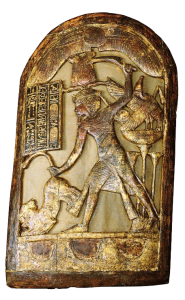 Tutankhamun’s tomb. It was on a flake of limestone, and represents the young king, aided by his hound, slaying a lion with a spear. It had been drawn by Rahotep as he contemplated the sad end of Pharaoh and the words spoken that day. He drew it while working on Tutankhamun’s tomb with his father Cato, and had been in a meditative mood while so doing; then he tossed it down by the entrance, where it was to be found many hundreds of years later!
Tutankhamun’s tomb. It was on a flake of limestone, and represents the young king, aided by his hound, slaying a lion with a spear. It had been drawn by Rahotep as he contemplated the sad end of Pharaoh and the words spoken that day. He drew it while working on Tutankhamun’s tomb with his father Cato, and had been in a meditative mood while so doing; then he tossed it down by the entrance, where it was to be found many hundreds of years later!
After the assassination of Tutankhamun, Ay and Maya debated who should take up the double crown and become Pharaoh. Ay did not want to be Pharaoh and asked Maya to ascend the throne, but Maya could not, for he was still the royal treasurer and, as such, had to remain free of official pressure. Besides, Maya was married, and any successor to Tutankhamun would have to marry the young heiress Ankhsenamun in order to legitimize his claim to the throne!
Since Ay’s wife Tyi was already dead, it was decided that he would ceremonially marry the widowed Queen—a marriage in name only, for Ay was a very elderly man and the Queen was still but a child!
Ankhsenamun did not understand this, and sent a letter to the Hittite King Shubbuliliuma in which she said: “My husband is dead; I have no male children; your sons are said to be grown up; if to me one of your sons you give, and he will be my husband and king, he will be a help; send him accordingly, and thereafter I will make him my husband. I send gifts.”
Time was short, for she had only seventy days, the time taken for the embalming and burial of her husband’s body.
The Hittite king waited too long to decide, and when he finally dispatched his youngest son it was too late. Maya and Ahmose met the prince before he entered Thebes, and explained that Ay was now Pharaoh in the land of Egypt because of his marriage to the Queen. The prince returned home bitter and sad; to have been a Hittite and King of Egypt at the same time—this would have been the supreme attainment!
King Tutankhamun was laid to rest in his small tomb on April 23, 1350 B.C.
The funeral arrangements had been costly and were well prepared and supervised. Never before had a successor to the throne actually personally supervised the construction and decoration of the tomb of his predecessor. But Ay and Maya wanted certain objects to be sealed up with Tutankhamun. It was for a record; a proof that Aton still lived in Egypt. The Amun priests did not care, for they had eliminated their source of contention—the channel “Ratut”!
Ankhsenamun was beside herself with grief; for put to rest with her husband in his tomb were the remains of two of her children by “Ratut.” One of these children had formerly been the murdered wife of Smenkhkare, Meritaton. She almost immediately reincarnated as one of the children of Tutankhamun and his queen. The other child had once been Genubath, son of Hadad the Edomite!
Why did these children die so young? It was to give the young rulers a saddening experience, if indeed they needed it, for their life was not too happy under the existing conditions brought about by Amunism. They served Aton, but they hardly led a normal, young life.
Now the King and Queen had a third child that did not die. She was known as Ankhsenpaaton the younger, and lived in the house of Maya as an adopted daughter to protect her from the priests.
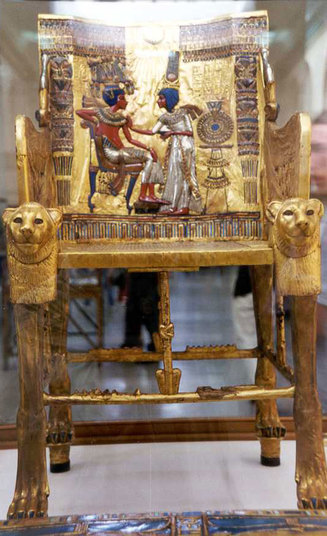 Maya chose young Rahotep to be the artist that would fashion the beaten and burnished golden portrait mask of ”Ratut.” This youth had designed the magnificent golden throne later discovered in the tomb by Howard Carter. Its legs, fashioned in feline form, were surmounted by lions’ heads, fascinating in their strength and simplicity. The chief glory of the throne was the panel of the back. The scene depicted here shows one of the halls of the palace. The King sits in an unconventional attitude upon a cushioned throne, his arm thrown carelessly across its back. Before him stands the slim figure of the Queen, gently anointing her husband’s shoulder and collar with perfume. It was a simple composition, but Rahotep had faithfully reproduced his two dear friends as he saw them— living, loving, and serving in strife-torn Egypt!
Maya chose young Rahotep to be the artist that would fashion the beaten and burnished golden portrait mask of ”Ratut.” This youth had designed the magnificent golden throne later discovered in the tomb by Howard Carter. Its legs, fashioned in feline form, were surmounted by lions’ heads, fascinating in their strength and simplicity. The chief glory of the throne was the panel of the back. The scene depicted here shows one of the halls of the palace. The King sits in an unconventional attitude upon a cushioned throne, his arm thrown carelessly across its back. Before him stands the slim figure of the Queen, gently anointing her husband’s shoulder and collar with perfume. It was a simple composition, but Rahotep had faithfully reproduced his two dear friends as he saw them— living, loving, and serving in strife-torn Egypt!
Above the King and Queen on the back panel of the throne Rahotep pictured the Aton with the outstretched arms gently caressing the royal pair.
Historians cannot understand why an object like the throne, which bore such manifest signs of Aton heresy upon it, would be publicly buried in this stronghold of Amun faith! Why did Tutankhamun still sit on an Aton throne when the very name of the One God had been forbidden nine years previously? It is true that the cartouches were changed on the throne, but not all of them. In some of them the Aton element was erased, and the Amun form substituted, but in others the Aton remains unchallenged.
The attempt made to change some of the names was enough to appease the Theban priests, and, after all, the throne was now being buried with the young ruler who, as he grew more into manhood, became a threat to their security. They were afraid that he might cause a holy, religious war and return Aton to his rightful place in Egypt. This way they were burying this threat, now very much dead—burying him and all the symbols of his accursed faith!
So Rahotep, the artist, created a throne not unlike the one he designed when he was the great Solomon!
Rahotep created in imperishable metal a beautiful portrait of his dead friend and king. It was made of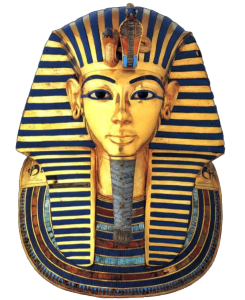 the “best“ gold—transmuted gold! And the artist was being used as a channel himself to perfect and complete this effigy mask, which is more than just a mask — much more!
the “best“ gold—transmuted gold! And the artist was being used as a channel himself to perfect and complete this effigy mask, which is more than just a mask — much more!
Maya had taken Rahotep’s father, Cato, to the secret chambers many times, blindfolded, until they were safe within the treasure rooms. Cato, being a great artist, interpreted many things for Maya, things of artistic worth. Cato learned the art of transmutation from these hidden documents and passed on the knowledge to his son. Rahotep worked under the direct guidance of a deceased Aton priest-artist.
All preparations having been made, the body of young Tutankhamun was placed upon a lion-shaped bier, ‘within a shrine resting upon a sledge. This was drawn by courtiers to the tomb in the Theban Valley. Over the dead king, llipaamun and the women of the court placed festoons of garlands.
Four lesser nobles and General Horemheb preceded the sledge; then followed Sinuhe and Maya together, and behind them Ahmose and Amenophis. Ay, as the new king, and his queen Ankhsenamun were already at the tomb preparing for the last rites. Besides, Ankhsenamun was weak and ill; she could not have gone with the body on its journey to the tomb.
So “Ratut” was brought to his tomb on this spring night in 1350 B.C. The funeral rites were presided over by King Ay. Maya placed an offering in the tomb showing the King reclining on a lion. Maya inscribed it with his name and an appropriate farewell message. Finally, the gathered group of nobles, present to pay final homage to Pharaoh, began to pass out of the tomb. The last three individuals in the tomb were Rahotep, Horemheb, and Ankhsenamun. The Queen was required by custom to be left alone with her deceased mate, and be the final one to bid him farewell.
Now, Rahotep’s strength had been depleted because of the great concentration needed to complete the mask and other funeral equipment. Being used as a channel while conceiving the transmuted mask was too much for this frail youth. Besides, the ordeal of seeing his friend die, and realizing he unknowingly caused this death (although innocent of any crime), was far too much for one so young. The entire Amun period was one of the cruellest man has ever experienced!
Rahotep left the tomb with General Horemheb, and, once outside, he fainted on the steps. It was thought the boy had died, because there was no perceptible pulse. But he was only in a trance condition—a coma brought on by his deep concentration and exhausting work. The others were no longer at the tomb entrance, and Horemheb very quickly had Rahotep buried on the spot. The General later informed Cato, when asked the whereabouts of his son: “Ra, thy son, perished at the tomb. The sight of his dead friend and Pharaoh was too much for the boy. I was forced to bury him at once; it would have been his wish.”
Cato retorted: “But he wasn’t mummified!”
Horemheb quickly answered: “But think of it, Cato, he doesn’t need mummification; he is now buried near the tomb of a Pharaoh—he shall enjoy the eternal pleasures of a god in the other life.”
Cato in his grief replied sarcastically: “Thank you, General, for your kindness and consideration; you always have the happiness of the people on your heart!”
Yet Cato knew that Rahotep would perish shortly after the supreme achievement of the golden mask; this was his purpose in life, and his duty was now fulfilled.
Outside the tomb several groups of slaves had been put to death by the priests, as was the custom of Amunism, to ensure the Pharaoh servants in the after-life. With these groups were the identical twins of the dark-skinned race of wizards! They desired to die at this time, for they had also completed their duty in Egypt. They were to protect Tutankhamun for his purpose of being a channel, and now they wished to die so that the Amun priests would never learn their secrets and powers they had brought with them from their strange land!
Inside the tomb, Ankhsenamun was paying her final tribute and visit with her young husband. She was trying to remember, in her girlish way, if all had been properly arranged as “Ratut” would have wanted it. She had always worried over him, her gentle and sensitive king. Did he have his favourite bow when he went hunting with Rahotep? Or was he dressed properly? These things were of great concern to her always, for she was very devoted, since he was her only true love.
She had seen to it that he carried with him to his tomb the rare iron dagger with the gold shaft and knob of rock crystal which had been given to him at Akhetaton by the Hittite ambassador when he was only seven years old. His favourite bow was in the tomb also.
Ankhsenamun thought of their brief reign and of their only happiness—their love and their service to Aton. She thought of the two children who rested in the same tomb—the little ones who never hardly lived at all.
 She had a farewell offering; not more gold, for the chamber was dazzling with the precious metal, but an offering that would please “Ratut.” Upon the brow of his effigy, as he lay in his quartzite sarcophagus, she placed a tiny wreath of flowers. Among all that regal splendour and royal magnificence there was nothing so beautiful as these flowers!
She had a farewell offering; not more gold, for the chamber was dazzling with the precious metal, but an offering that would please “Ratut.” Upon the brow of his effigy, as he lay in his quartzite sarcophagus, she placed a tiny wreath of flowers. Among all that regal splendour and royal magnificence there was nothing so beautiful as these flowers!
Ankhsenamun was in the burial chamber for the last time, and with her own fingers she gently drew over her husband the shrouds beneath which he was to rest undisturbed for over three thousand years.
She turned to go, and, in a final gesture of affection and grief, she placed beside the entrance to the ante-chamber a bouquet of delicate wild flowers. Then she mounted the sixteen steps to the outside, where she beheld the heavens where Aton is Lord. She knew that ”Ratut“ had once come from one of the stars (Hesperus) in that sky. She knew too that some time in the far distant future she would meet her king again.
Before turning towards Thebes, where she was now Queen with Pharaoh Ay, she said: “Oh, Aton, until you ordain we meet again, spread thy eternal wings over Ratut as the Imperishable Stars.”
The father of Nefretiti only reigned four years (1350—1346 B.C.), and Ankhsenamun never recovered from her illness and died of a broken heart in 1348 B.C.
The tomb was entered a few years after the burial by robbers, but two of them were caught in the act and subsequently died because of the vibration which had been placed around the tomb by the magician twins just before they perished in front of it. One robber had escaped, but died shortly afterwards. He had taken the solid gold statuette from its pedestal in the small golden shrine. This statuette has never been found, but it was a beautiful representation of Tutankhamun’s father, Amunhotep III. It had been inscribed: “To my unborn son, whom I have not yet seen.”
The proof that the robbers were caught in the act is the fact that a precious bundle of solid gold rings was left in the tomb—the last thing a thief would be likely to forget!
Maya and other officials removed all written documents from the tomb and resealed it after the robbery, and buried the entire entrance to the tomb so that it might be completely hid from view. And they were successful, for no hand touched the seals upon the door until Howard Carter made his world-famous discovery in 1922!
The written documents removed by Maya gave a complete history of the dead king and told of his true parentage. That he was truly the son of Amunhotep III can be proven by the cartouche on a magnificent red granite lion now in the British Museum (Gebel Barkal lion). This lion bears the cartouche of Tutankhamun, who expressly states that he is “the restorer of the monument of his father, Amunhotep.”
The Pharaohs were not buried in splendour just to satisfy vain glory or pride; it was to preserve literal “Time Capsules” for future man. The symbols of Atonism years after it was forbidden, found in Tutankhamun’s tomb, prove that the youth was an Atonist to the end. It has been said that once he returned to Thebes from Akhetaton, he restored the monuments and temples of the old gods and Amun. But Tutankhamun’s long security in his tomb was not due to the fact that Amun protected the King because he acknowledged the false god’s triumph over the religious revival of Akhnaton. “Ratut” actually did not reconstruct Amun’s sanctuaries and re-endow his temples, but the priests did it in Tutankhamun’s name!
The Pharaohs of the early Eighteenth Dynasty decided to use the Valley of the Tombs of the Kings for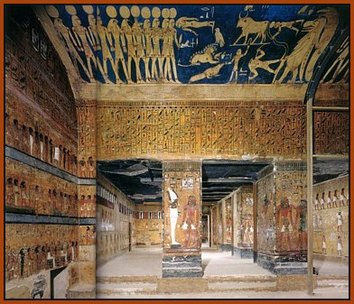 burial purposes. Its loneliness and comparative inaccessibility recommended it for the tombs that were to be record chambers, not just the luxurious apartments of dead kings! The valley was the ideal place for carrying out the experiment of a new method of concealment for the royal burials.
burial purposes. Its loneliness and comparative inaccessibility recommended it for the tombs that were to be record chambers, not just the luxurious apartments of dead kings! The valley was the ideal place for carrying out the experiment of a new method of concealment for the royal burials.
Information was placed in these tombs, and Tutankhamun’s was better preserved because of the so-called “curse.” Actually, it was a “blessing” and not a “curse” that was placed on the tomb. It was a “blessing” to ensure Divine protection and also to ensure a certain vibrational frequency that would endure until it was time for the information within the tomb to be released to mankind.
By the time the twentieth-century archaeologist had returned to this tomb, the force field had diminished until it was almost non-effective. Nevertheless, it still proved fatal to several of the excavators and scientists who entered the tomb. Lord Carnarvon had once been a high priest of Amun; now he had to return to life and make possible this discovery. The archaeologist himself had to return also to the very tomb he once stood inside of. By revealing the contents of the tomb to the world he paid in part for his action in turning his back on Aton!
So Ay ruled for only four years, and then, fearing that he would be poisoned, he literally starved himself to death.
Sinuhe, since he was a son of Amunhotep III, became Pharaoh and reigned for one short month as King Setymeramun. He was then buried in Akhnaton’s empty royal tomb, and later the mummy was burned.
The cheese-maker’s son, Horemheb—the blood-spattered soldier of Egypt—became Pharaoh. He ruled from 1346 B.C. to 1322 B.C., and was the last Pharaoh of the Eighteenth Dynasty. He married Princess Beketamun, which legitimized his succession to the throne.
Horemheb usurped the throne and started a blood-bath that ended only in his own death in 1322 B.C. It was he who chased a group of Israelites leaving Egypt in another wave of the Lesser Exodus, and because of this historians later confused his cruel acts with the so-called “Pharaoh of the Oppression” and “Pharaoh of the Exodus.” However, Horemheb was not drowned in any Red Sea. But he hacked names from monuments; he didn’t have any love for Aton, Amun, or any other gods—he adored only himself; Horemheb. He did everything in his power to see to it that only he would be remembered in Egypt. He is remembered, but not for that which he wished!
Mankind had seen for a short time the Greater Light, but, as always, after the Light dimmed terror overtook the world. Then when the last vestiges of Atonism had been removed, including the Workers, that Light went out in Egypt, and was not seen again on earth for centuries. With Horemheb the Light went out like a sputtering candle, and with it the Eighteenth Dynasty fell.
Maya, Ilipaamun, Tantahpe, Ankhsenpaaton the Younger, and all the rest of the followers and labourers who served Akhnaton and Aton perished at the hand of Horemheb. Maya was an old man of ninety years when he and all the others were beheaded in the most cruel fashion! Cato too was there in the house of Maya when this happened and he met the same end.
The Atonists had told the world that man did not need priests to act as intermediaries with the One God, for Aton was the God of all people and therefore accessible to all!
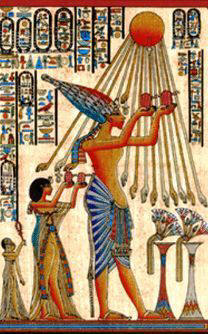 The man on the Nile could talk with God as well as Pharaoh. The Gospel brought by Akhnaton was the forerunner of the Gospel of Jesus the Christ! Akhnaton spoke of Universal Truth and the Master Jesus proved the same Truth by performing Divine Miracles!
The man on the Nile could talk with God as well as Pharaoh. The Gospel brought by Akhnaton was the forerunner of the Gospel of Jesus the Christ! Akhnaton spoke of Universal Truth and the Master Jesus proved the same Truth by performing Divine Miracles!
If the world had accepted the Greater Light from Akhnaton and the other members of the ”Goodly Company” Egypt would have later produced the greatest Pharaoh of them all, for the Christ-Spirit would have incarnated as Pharaoh Sananda! But the experiment failed, for the time being!
The Dawn had come to earth—and is not always the Dawn glorious? The golden rays of Father Aton shone on the dust of earth and touched the dark hearts of men, and mankind had a glimpse into the “pool of knowing“; they disturbed its surface (reflective knowing) when Pharaoh Akhnaton brought Aton to the period of the Dawn.
Excerpt from Secret Places of The Lion by George Hunt Williamson
See Part I here See Part II here See Part III here See Part IV here
Posted in True History of Manwith 1 comment.


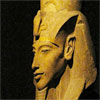
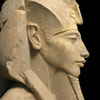
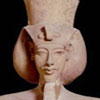

Just as I had finished this post, I stepped outside to do some tree trimming before the sunlight was gone and lo and behold a beautiful five inch gold and black butterfly appears and bobs around me for several minutes. I look on in wonder thinking as I always take a bit of convincing that this was perhaps confirmation of the truth written here. The colors were like the colors of his mask. Very beautiful exquisite like an ‘Egyptian’ tapestry. A butterfly that I have never seen before.